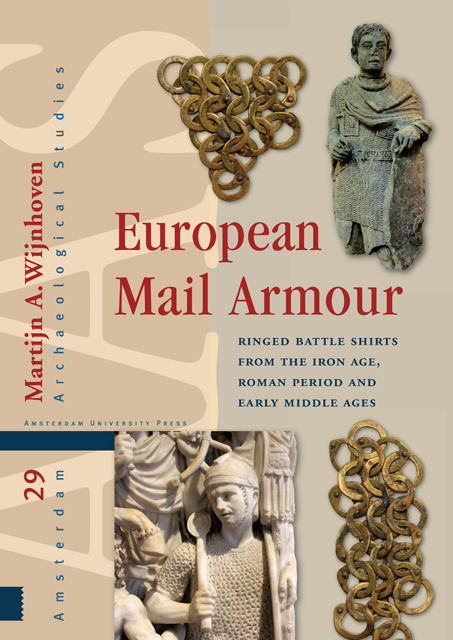Book contents
- Frontmatter
- Contents
- Acknowledgements
- Dedication
- 1 Introduction
- 2 The origins of mail armour
- 3 Distribution and archaeological context
- 4 The iconography of early mail armour
- 5 The naming of mail armour
- 6 Decoration in mail garments
- 7 Padded garments
- 8 The craft of making mail rings
- 9 Weaving patterns
- 10 The construction of mail garments
- 11 Ring characteristics
- 12 Final considerations
- Bibliography
- Database
- Appendix 1 Catalogue of mail armour
- Appendix 2 Catalogue of hybrid armour
- Appendix 3 Catalogue of isolated finds of fasteners and fixtures
- Appendix 4 Finds excluded from the database
10 - The construction of mail garments
Published online by Cambridge University Press: 24 November 2022
- Frontmatter
- Contents
- Acknowledgements
- Dedication
- 1 Introduction
- 2 The origins of mail armour
- 3 Distribution and archaeological context
- 4 The iconography of early mail armour
- 5 The naming of mail armour
- 6 Decoration in mail garments
- 7 Padded garments
- 8 The craft of making mail rings
- 9 Weaving patterns
- 10 The construction of mail garments
- 11 Ring characteristics
- 12 Final considerations
- Bibliography
- Database
- Appendix 1 Catalogue of mail armour
- Appendix 2 Catalogue of hybrid armour
- Appendix 3 Catalogue of isolated finds of fasteners and fixtures
- Appendix 4 Finds excluded from the database
Summary
‘Craftsmen do not use patterns and techniques at random; they tend to adhere to the methods which they have been taught. This would be especially true of a craft so ancient and repetitive as mail-making. It is the writer's belief that the patterns found in mail have a very real historical, and perhaps geographical, significance. Investigation into these patterns may be the road to further knowledge of a craft which probably died out within the last century…’
E. Martin BurgessAs a specific type of body armour, mail has featured prominently in many studies on the development of arms and armour. But it was not until the mid-20th century, with the publication of E. Martin Burgess's Further research into the construction of mail garments, that the construction of the mail coat was better understood. His study and subsequent work, however, concerned only ‘historical’ mail coats from the Late Middle Ages and Renaissance which had survived into modernity being passed down from owner to owner. The same is true for other scholars that followed in his footsteps.
The construction of mail before the 14th century, by contrast, has remained unexamined, mainly due to the fact that almost no historical mail from those times has survived. For earlier periods we depend entirely on mail from archaeological contexts, the condition of which is usually far from ideal. Excavated mail is often so profoundly corroded that they reveal little, if anything, about its construction.
Fortunately, not all of the mail retrieved archaeologically is that decayed. Some remains preserve their original flexibility, with movement of the individual rings. One of the best-known examples, and perhaps the best-preserved, is a coat of mail from Vimose 1, Denmark, which dates back to the second half of the 2nd or early 3rd century AD. This specimen is almost complete and still entirely flexible, which makes it one of the highlights of the Nationalmuseet in Copenhagen. Other flexible mail remains include those from the Iron Age site of Radovanu in Romania and the Roman Iron Age site of Thorsberg in Germany.
While such archaeological finds can offer information about the construction of the mail coat, no work has been done on this subject previously.
- Type
- Chapter
- Information
- European Mail ArmourRinged Battle Shirts from the Iron Age, Roman Period and Early Middle Ages, pp. 223 - 258Publisher: Amsterdam University PressPrint publication year: 2021



